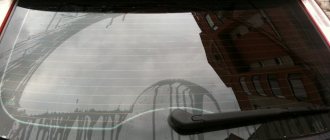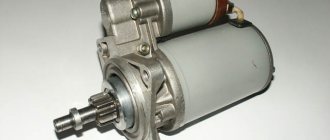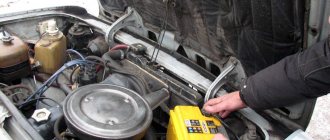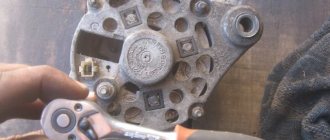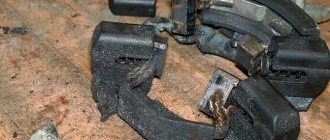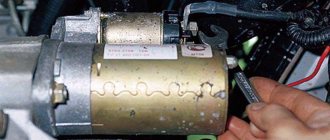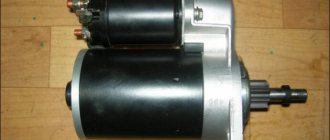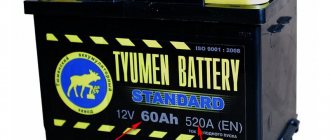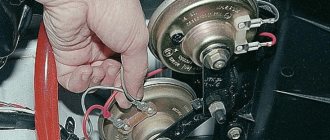VAZ 2107 starter does not turn: what to do?
The situation when there is no reaction when turning the key in the ignition switch is known to almost every motorist, especially owners of domestic models. If the instrument panel lights up, then the problem is not with the battery, but perhaps with a device such as the starter. We are interested in the starter on the VAZ 2107, but since these devices are identical on almost all domestically produced cars, this means that they have the same problems with malfunctions. If the VAZ 2107 starter does not turn, then it’s time to carry out diagnostics and find the breakdown. Let's figure out why the product for starting the engine may not function.
Repairing a starter on a VAZ 2107 with your own hands - your eyes are afraid, your hands are repairing
Hello, dear car enthusiasts! We will continue to master the features of operation, diagnostics and repair of the main components of domestic cars. In principle, this material is also suitable for those who own foreign cars. At least to understand the essence of the problems.
After all, no matter how you twist the starter, on a foreign car and in a Zhiguli or Lada, it is practically the same. The difference may be insignificant in design, and a new principle of operation of the starter for production cars has not yet been invented.
Therefore, we will consider the technology for repairing the starter on the VAZ 2107. Repairing the VAZ 2107 starter, first of all, consists of performing actions aimed at identifying and eliminating possible problems. Typically, such repairs do not cause any difficulties and are quite feasible even for a novice auto mechanic.
Possible malfunctions of the VAZ 2107 starter and methods for eliminating them
Malfunctions of the VAZ 2107 starter cannot be called fundamentally different from malfunctions of starters of other Zhiguli models. However, when starting to diagnose the condition and repair the starter, it is necessary to have a clear understanding of possible problems in its operation.
For example, do you know what actions you should take when the VAZ 2107 starter turns poorly or does not turn when you turn the key in the lock? In this situation, first of all, pay attention to the warning lights. If they light dimly or go out periodically, your problem can be considered solved - most likely your battery is simply discharged.
Of course, a low battery charge cannot be the only reason for poor starter performance. For example, the starter armature will not rotate if the battery pole terminals and wire tips are heavily oxidized. Clean them and apply Vaseline. And if the tips are loose, tighten them more.
If there is an interturn short to ground or a break in the relay's pull-in winding, you will have to change the relay - there is no other way to change the situation.
To eliminate breaks in the relay power supply circuit and in the power supply circuit of the turn-on relay winding, check the wire connections in the circuit.
Sometimes, when the starter is turned on, the traction relay is activated, but does not turn: the armature either does not rotate at all or rotates very slowly. In this case, these may be symptoms of burning of the collector, which will only need to be cleaned.
The reason for this situation may also be wear or sticking of the brushes. In this case, the brushes must be replaced.
It happens that after turning on the starter, only the armature rotates, while the flywheel remains stationary. Such a breakdown can be caused by slippage in the movement of the freewheel, rupture of the clutch ring, or slipping along the axis of the clutch engagement lever. In such cases, the clutch and engagement lever must be replaced.
An uncharacteristic sound made by the starter when the armature rotates may indicate a weakened fastening of the starter, its fastening is skewed, damage to the teeth of the flywheel drive gears, or wear of the bearing bushings.
How to check the VAZ 2107 starter yourself?
It cannot be that you are not interested in the question of how to check the VAZ 2107 starter yourself, without resorting to the help of specialists from the service center?
We suggest that you familiarize yourself with a sequential methodology, following which you can get an idea of the condition of the starter of a VAZ 2107 car:
- Remove the starter from the car and clean its outer surface of dirt.
- Connect the terminals of the solenoid relay and the battery (in this case, the starter housing must be connected to its negative terminal)
- To check the armature and stator windings, remove the starter rear cover and disconnect the brush assembly
- Using an ohmmeter, check that the windings are not shorted to the housing. If there is no short circuit, the minimum readings of the device will be 10 kOhm
- Check the windings for breaks. To do this, connect the ohmmeter probes to the terminals of the windings. If you notice the ohmmeter readings tending to infinity, regard this as a winding break.
- Make sure that the armature is not shorted to ground - attach the ohmmeter probe to the body, and alternately connect the second one to the contact plates. If there is no short circuit, the ohmmeter reading will be at least 10 kOhm.
Only at first glance, the work associated with repairing a starter may seem complicated. But having done it at least once, you can easily diagnose and fix most breakdowns of the Zhiguli starter of the seventh model.
Troubleshooting
If you operate a car for a long time without carrying out diagnostics and technical inspections, then everything will end in failure. If the engine does not start, then this breakdown can be repaired in a few minutes or in a few hours, depending on the type of breakdown. How can you determine why the starter does not turn? The main types of breakdowns include the following factors:
The simplest but most common breakdown of the starter on the VAZ 2107 is oxidation of the contacts. Moreover, the contacts oxidize both on the device itself and on the battery.
A more complex breakdown is usually associated with a malfunction of the solenoid relay, as well as rotor wear, breakage of windings, brushes and slip rings.
Burnout of the solenoid relay contacts. The exact breakdown of the mechanism can be determined after its dismantling. After removing the unit, you should check the condition of the main components, both the solenoid relay and the device itself. The resistance of the windings, the presence of breaks or short circuits, the presence of oxidation, contacts, etc. are checked. Once the cause of the breakdown is identified, it should be eliminated if possible, or the entire mechanism should be replaced.
The main reasons why the device does not spin
Let's consider the main reasons for such consequences in which the starter does not function.
The battery is low. It is very easy to identify such a breakdown. If you turn the key in the ignition, and there are no signs of life in response, and the lights on the panel have completely gone out, then the reason lies directly in the battery. The problem can be corrected by charging the battery. If the battery has a weak charge, at which the control panel operates, then when you try to start the engine, clicks of the relay operation will be heard.
Lack of ground on the solenoid relay. The mass can disappear for several reasons: contact oxidation, wire breakage, loosening of the nuts. If there is no “mass”, then the unit may not show any signs of life, or may work only once in a while. The situation can be corrected by stripping the contacts and tightening them, or by checking the supply wires.
Break in the circuit. If the relay does not click after trying to start the engine, then the failure may lie in the ignition contact group. The fault can be determined by checking the presence of contact between the ignition and the starter.
Solenoid relay malfunction. A malfunction of the solenoid relay can be eliminated by replacing it or, sometimes, repairing it.
The malfunction may also consist of a broken wire between the solenoid relay and the starter relay, through which power is supplied when the key is turned in the ignition switch.
How to recognize malfunctions
The starter should not be blamed if the engine does not start for the simple reason that the fault may lie in other devices. The malfunction of the device in question on the VAZ-2107 can be identified by the following signs:
- The car does not start, but the starter is buzzing. The reason is a malfunction of the retractor mechanism.
- Silence from the starter when turning the key in the ignition.
- The engine starts after several unsuccessful attempts to start it.
- The device continues to function after the engine is started.
- The presence of noise, grinding and knocking when the car is moving.
The presence of one of the above-mentioned signs indicates that the fault must be sought in this mechanism.
Unit repair
The estimated service life of the product is about 5-6 years. If the mechanism is used significantly, it should be replaced with a new one. You can check the serviceability of the solenoid relay by applying power to the product. The “+” power from the battery is connected to terminal “50”, and the “ground” is supplied to the unit body. If the product is in good working order, a quick and loud click will be heard. There will be no click on a faulty device. You can replace only the solenoid relay, but first carry out a full diagnosis.
Assessing the scale of the problem
If, when you turn the key in the ignition switch, the starter does not turn, no clicks or sounds are heard, then the reason may be this:
- the battery is discharged or faulty;
- battery contacts are oxidized;
- problem with the contacts of the starter itself;
- a break in the windings of the device or the electrical circuit of the car.
When the starter turns slowly, clicks of the traction relay are heard, the reason may be this:
- there is a charge in the battery, but it is not enough to properly spin the moving parts of the starter;
- carbon deposits have formed on the contacts or they have oxidized;
- worn brushes or burnt commutator;
- short circuits in windings or brush holders.
Starter brush wear
Repeated operation of the relay and its spontaneous shutdown can be caused by a voltage drop in the network due to oxidized contacts or a malfunction of the traction relay. When the starter turns, but the flywheel does not rotate, there may be several reasons:
- problem with the freewheel (Bendix);
- drive or flywheel teeth are damaged;
- The bearings or springs of the traction relay are worn out.
These are perhaps the main malfunctions and their most common explanations. They are equally valid for carburetor models and injectors.
What to do if the starter clicks but does not turn on a VAZ-2107
Drivers of a VAZ-2107 car have probably at least once encountered a situation where, when turning the ignition key, nothing happens, the car is “silent” or clicks are heard. This happens when the starter (the device that starts the car) fails. Perhaps this situation will drive some people into panic, but there is no need to worry. You just need to contact a car repair shop or deal with the breakdown and carry out the repair yourself. In our article we will discuss in detail what such a malfunction could be, what you need to have in stock for repairs, and how to carry out such work yourself.
Why doesn't the starter click or turn?
The starter in the design of vehicles ensures the start of the power unit. Therefore, when problems arise with starting, most car owners ask themselves: why did the starter stop turning and why does its retractor not click? Despite the fact that the operation of the engine starting device lasts only a few seconds, its breakdown completely paralyzes the operation of the car, since the engine can be started normally only with a pusher, although this is only possible with a manual transmission (manual gearbox), or with the help of a crooked starter (if it is provided for by the design).
You can determine the cause of a malfunction in the engine starting system and troubleshoot problems yourself, especially since this does not require complex diagnostic instruments and tools. But it will be impossible to diagnose the starter’s performance without measuring instruments, the most accessible of which is a multimeter.
The starter clicks but doesn't turn over
In most cases, if when you turn the key the engine does not start, but only clicks are heard, the reason must be sought in the solenoid relay. Although there may be other malfunctions, for example, damage to the wires or others, for example:
- The battery is dead. Sometimes it happens that the problem is not in the starter at all, but in the battery, which is discharged and simply does not have enough strength to start the engine. In this case, nothing will click; rather, a repeated cracking sound will be heard. This cannot even be called a breakdown; the battery is either recharged or the battery in it is replaced.
- The positive terminal has contacts in poor condition. It is necessary to inspect the clamps on the battery, and if they are oxidized, they need to be cleaned. One of the cables from the positive terminal goes directly to one of the contacts of the solenoid relay. Accordingly, if it is in poor condition or oxidized, the system will malfunction and “click”, but in such a situation this is not the most serious problem.
- Poor contact at the relay. The starter also has wires that can oxidize. The reason for this is the long mileage. They must be disconnected, inspected and, if necessary, cleaned.
- Poor ground contact. The terminal with a minus sign is connected to ground, and if the wires are oxidized on the terminal side or at the point of contact, this can also cause a breakdown. And again, everything needs to be cleaned.
- Solenoid relay. This type of malfunction occurs quite often. When you turn the key, nothing happens, you just hear clicks. When you turn it several times, the engine will, of course, start, but in this case the relay must be replaced with a new one, since this is the cause of the breakdown.
The bendix teeth or the flywheel crown may be broken. In such a situation, not only clicks will be heard, but also a crunching sound under the hood of the car.
VAZ 2107 starter repair
The VAZ 2107 starter consists of:
- housings;
- anchors;
- drive;
- relay.
To repair the device you will need:
- bushing puller;
- drill with metal drill bit;
- pliers;
- flat blade screwdriver;
- a set of wrenches and pipe wrenches;
Removing the starter
It is quite easy to remove the VAZ 2107 starter on an inspection hole or overpass. Otherwise, the car is jacked up and supports are placed under the body. All work is carried out lying under the car. To dismantle the starter it is necessary.
- Disconnect the battery by removing the wires from the terminals.
- Remove the rear mudguard (if equipped).
- Unscrew the fastening bolt located at the bottom of the starter shield.
Video: dismantling the VAZ 2107 starter without an inspection hole
Disassembling the starter
When disassembling the VAZ 2107 starter, you should perform the following steps.
- Unscrew the large nut of the traction relay.
Replacing starter bushings
Signs of wear on the starter bushings are:
- large play of the anchor shaft;
- marks from the armature on the windings that it touches during rotation.
The bushings are changed on a disassembled starter. Bushings are distinguished:
- checkpoints;
- impassable.
The first ones are knocked out with a drift of the appropriate size or with a bolt whose diameter corresponds to the outer diameter of the sleeve.
The no-go rear bushing is removed using a puller or drilled out.
To replace the bushings you will need a repair kit. New bushings are usually made of cermet. It will also be necessary to select the appropriate mandrel size. The bushings should be pressed in extremely carefully, avoiding strong impacts, since cermet is a rather fragile material.
Experts recommend placing new bushings in a container with engine oil for 5–10 minutes before installation. During this time, the material will absorb oil and provide good lubrication during further operation. The bushings of the standard VAZ 2107 starter are made of bronze and are more durable.
Replacing electric brushes
Often the starter fails due to wear on the electric brushes or carbons. Diagnosing and fixing the problem is quite simple.
The coal is a graphite or copper-graphite parallelepiped with a connected and pressed stranded wire and an aluminum fastener. The number of embers corresponds to the number of poles in the starter.
To replace the brushes you will need:
- Remove the starter rear cover.
- Unscrew the bolts securing the brushes.
- Pull out the brushes.
In this case, you can unscrew only one bolt that secures the protective bracket, under which the embers are located.
The VAZ 2107 starter has four brushes, each of which can be removed through a separate window.
Repair of starter retractor relay
The main function of the solenoid relay is to move the starter gear until it engages the flywheel while simultaneously supplying power. This relay is mounted on the starter housing.
In addition, the VAZ 2107 also has a power relay that directly controls the power supply. It can be located in various places under the hood of the car and is usually secured with a single screw.
If the solenoid relay is faulty, first check the control relay. Sometimes repairs are limited to replacing a slipped wire, tightening a loose screw, or restoring oxidized contacts. After this, the elements of the solenoid relay are checked:
- frame;
- anchor;
- contacts;
- magnetic system;
- return spring.
Be sure to inspect the retractor relay housing. If cracks appear, voltage leakage will occur, and such a relay must be replaced with a new one. There is no point in repairing the traction relay.
Diagnosis of malfunctions of the solenoid relay is carried out in the following order:
- The operation of the starter is checked. If you hear clicking noises when you turn the ignition key and the engine does not start, the starter is faulty, not the relay.
- The starter is connected directly, bypassing the relay. If it works, the solenoid relay needs to be replaced.
- A multimeter measures the resistance of the windings. The holding winding should have a resistance of 75 Ohms, the pull-in winding - 55 Ohms.
You can replace the solenoid relay without dismantling the starter. For this it is necessary.
- Disconnect the battery.
- Clean the solenoid relay and contacts from dirt.
- Remove the contact from the bolt.
Reassembly and installation of the relay is carried out in the reverse order. After completing the work, it is necessary to check the functionality of the starter.
Starter assembly and installation
During the process of disassembling the starter, it is necessary to remember or mark where the bolts, screws and other small parts were removed. The device should be assembled very carefully. In this case, you must remember to tighten the stopper that holds the fork in the front cover.
Thus, diagnosing a malfunction, repairing or replacing the VAZ 2107 starter is quite simple. This does not require any special skills. A standard set of plumbing tools and instructions from specialists will be enough to do the work yourself.
The starter hums, but the engine is silent
In this case, the cause of the breakdown is the bendix (it does not click).
And the buzzing is heard due to the fact that the anchor gets caught on the flywheel, and the launch does not occur. The starter works, turning the armature at high speed, but the engine flywheel does not spin up. Note: when the eccentrics stop functioning normally, the bendix begins to spin in different directions (should only go in one direction), and the gear rotates in the flywheel splines. And the result is a buzzing sound.
If you try really hard, in theory you can repair the gear, but it will be expensive, it will be difficult to find the eccentrics, and it may simply not be possible to put everything back together. In such a situation, it is more advisable to replace the entire assembly by first removing and completely disassembling the starter.
Take care of your car, carry out repairs in a timely manner, and it will serve you for as long as possible.
Why does the starter click but does not turn on a VAZ-2107
A person quickly adapts to any conditions, and especially to comfort. If you actively use your car, and then suddenly, due to a malfunction, send it to a technical center for repairs, you are left with no hands. But even worse is the situation when the car suddenly stops starting, even though everything was working perfectly yesterday. When you turn the ignition key, the starter clicks, but does not turn, and your VAZ-2107 stands rooted to the spot. For a novice car owner, this can be a real reason for panic, and for an experienced one, it can be another reason to get under the hood of an iron horse.
Why does this happen
The reasons for this behavior of the starter can be several factors.
For those who may have forgotten, let us remind you: the starter is an electric motor with a short period of operation and, by definition, it is easy to assume that it is not intended for long-term operation. During braking, it engages with the flywheel, drawing voltage up to 350A. That is why, when forced to work for a long time, the device malfunctions.
The click that is heard when the starting mechanism supposedly breaks down does not actually belong to it, but to its traction relay. The latter has a pair of windings - one is designed for holding, the second for retraction. When the relay clicks, it is due to the following. One stroke of the appropriate purpose draws in the core. But a voltage deficiency develops in the holding winding, and the pull-in winding misses the core.
And so the process is repeated several times while the key is in the “starter” position.
Since the traction relay in any model is identical, the brand of the car does not matter: VAZ, KIA or even BMW - the principle is the same for all.
A working mechanism starts up on the second attempt at most, but mostly on the first. If it's broken, it won't start at three. Therefore, you should not mock the engine until the battery runs out.
Situations in which the starter clicks but does not turn
Multiple and frequent sounds in the device:
- insufficient charge in the battery - check the charge current;
- Incorrect weight of the body with the engine - duplicate the weight with an additional drive;
- There is unstable contact at the battery terminals.
Single sound in the device:
- contacts are burnt - disassemble the device and then clean the contacts;
- check the engine mass;
- check the reliability of the starter latch with the traction relay;
- The starter is broken - you can only determine for sure after disassembly.
Circumstances associated with this behavior of the starter:
- the wire leading to the relay was burnt;
- brushes are worn out;
- anchor jammed;
- the winding is short-circuited;
- the winding is broken;
- broken or deformed fork with bendix drive;
- Bendix teeth clogged;
- Bendix is broken.
To determine the breakdown, it is enough to use an autotester to determine the voltage level of the starter power bolt, to which direct current from the battery is applied.
Then transfer the probe of the device being tested to the connection bolt at the starter output. You will need an assistant who will turn the key to the “Start” position at this moment. The following scenarios are possible:
- For example, at the input the tester showed 13.2 V, which indicates a fully charged car battery, and a similar voltage was obtained at the relay output. This means that the contacts are working properly, and, most likely, the cause of the problem lies in the starter itself.
- If the battery input is 13.2 V, and when the relay is activated there is a click and a voltage of 5-6 V, the bolts of the retraction element are burnt, which is why all the voltage is transferred due to poor contact.
What to do if the starter does not turn over?
Reliable engine starting in a car depends on many factors and, first of all, on the serviceability of the mechanisms. The VAZ 2107 is equipped with an electric starter, which turns the engine flywheel through a movable overrunning clutch. Among drivers it is often called Bendix. Starter failure can be caused either by malfunctions of its individual parts or components or by a simple discharge of the battery.
Typically, a similar situation occurs in winter or after a VAZ 2107 has been parked for a long time in an open parking lot or garage. Characteristic signs are clicking sounds of the starter solenoid relay, slow rotation or its complete absence. Troubleshooting involves charging the battery using a special device. After installing a new battery, it is easy to verify that the starter works well and spins the engine.
Troubleshooting
Long-term operation of a VAZ 2107 car can lead to failure or breakdown of individual components and mechanisms. How to determine why the car starter does not turn? Possible reasons for the mechanism to not work are as follows:
- Oxidation of contacts directly on the device, damage to the battery ground wire.
- Failure of the starter solenoid relay, breakage of the rotor windings, deterioration of brushes and slip rings.
- Breakdown of the solenoid relay, burnt contacts.
It is possible to determine exactly why the starter failed on a VAZ 2107 car only after dismantling and disassembling. It is much more difficult if the device either turns or does not work at all when you turn the key in the ignition. Such faults are diagnosed with great difficulty and usually, after fruitless searches, the unit is simply replaced with a new one or one that is known to be operational.
Starter: device and principle of its operation
In all cars, including the VAZ-2107, the starter performs one of the main functions - it starts the engine. To start the engine, you need to turn the crankshaft and thus create a flash of the fuel mixture in one of the cylinders. For this, a starter is needed - an electric motor in which alternating current is constantly present.
When the ignition switch contacts close, current flows through the windings. The electromagnet core retracts, and the lever connected to it moves the Bendix gear. At the same time, the core creates pressure on the plate, which closes the contacts at the moment the gear engages with the flywheel. The current through the closed contacts enters the motor winding and creates a magnetic field that rotates the crankshaft. When the engine is already running, the starter must be turned off. The key in the ignition switch is turned back, the magnetic field disappears, and the device goes into a resting state.
Structurally, the starter consists of the following elements: an electric motor, a retractor relay and an overrunning clutch with a gear (Bendix). Each component performs a specific function, and if something fails, the entire system does not work.
Removing the mechanism
The work of dismantling the device from the engine of a VAZ 2107 car will be carried out using the following tool:
- a set of open-end and ring wrenches;
- set of heads with a knob;
- flathead and Phillips head screwdrivers.
Once you are finally convinced that the electric starter is faulty, or rather that it does not turn the crankshaft, you can begin dismantling.
The sequence of operation performed by the wizard is as follows:
- Open the hood, disconnect the terminals from the battery and remove it from the engine compartment.
- We disconnect the starter, which does not turn the engine from the on-board network.
- Using a “13” key, unscrew the bolts securing the mechanism in the engine cylinder block.
- Carefully push the device out of the socket and remove the starter from under the hood.
In order to determine the exact cause of the malfunction of the engine starting mechanism on the VAZ 2107, it should be disassembled. The main purpose of such an operation is to detect defects in starter parts and assemblies through visual inspection. It is recommended to use a multimeter to check electrical circuits. If the car starter does not work well and intermittently, disturbances in circuits and contacts are possible.
The starter does not turn. Reasons, solutions
Good day! I haven’t been writing often lately because I’ve been busy painting my car and all my free time is being consumed by preparation.
The background to writing this post was a friend’s request that the starter of his VAZ 2106 did not turn the engine as it should. This prompted me to write a theoretical post about the common causes of this most unpleasant phenomenon.
Starter VAZ 2101-07 cross-section
To begin with, we should indicate that a starter is an electric motor that is designed to start a vehicle engine. Looking at the root, we see that since the starter is an electric motor, it is accordingly powered by a battery. This leads to several main reasons why the starter does not turn the engine properly. Let's name them all (maybe not all, but those that come to mind):
- The battery is low
- Poor contact at battery terminals
- Unreliable wire contact between the engine and the car body
- Burning nickels in the retractor relay
- Stuck or worn brushes
- Commutator burnout due to unreliable contact or stuck starter brushes
- Short circuit between commutator contact plates
- Wear of armature shaft bushings
- Burnout or burning of the stator windings or starter armature
Well, we seem to have briefly described the main malfunctions of the starter. I may not give some reasons (the engine is jammed, the starter is unscrewed, etc.), but here I am counting on your common sense, the serviceability of the electrical system, etc.
Now let's go through everything in order. The first and most obvious reason that the starter of your car does not turn is the discharge of the main source of electricity in the car - the battery. The solution to this problem is simple:
- Find the cause of battery discharge
- Charge the battery
- If you can’t charge it, then replace it with a new one, borrow for a while from friends and acquaintances
It is quite difficult to deal with unreliable contact in the terminals; the main difficulty is the oxidation of the terminals over time due to exposure to electrolyte vapors. It has been noticed more than once; as soon as a white or green coating appears, the starter rotates the engine much more lazily, especially in winter. Also, the use of dismountable terminals from the market does not contribute to the best current transmission, those that allow you to clamp the wires with two screws and cost about 12 - 15 UAH. Their problem is rapid oxidation, poor quality crimping of the wires (lead is a rather ductile metal and even if you press the fastener quite tightly, it does not guarantee anything, since positive temperature affects and the properties of this metal and the wires begin to wobble anyway), not high quality workmanship. After checking the battery, you need to thoroughly clean the wires and terminals of deposits, maybe this will help you, if not, then read on.
The following situation is familiar to me personally, I also observed it on about 5 - 6 cars. It consists in the fact that the contact between the engine and the car body is broken. There may be several reasons, the main ones being a break in the wire that connects the body and the engine, as well as oxidation at the point where this wire is attached to the body. This wire, which connects the body and the engine, is located (in VAZ 2101 - 2107 cars) on the left side near the gearbox. This problem can be cured with the help of an additional wire from the engine to the body, it is important with a suitable cross-section. For quick diagnostics, it is enough to connect the wire that goes from the battery to ground directly to the engine. If it helps, just add a wire.
One of the most common reasons that the starter does not turn is the burning of the nickels (contacts) in the solenoid relay. During long-term operation and frequent engine starts, the contact in this place is broken and becomes unable to provide the necessary current to rotate the starter. This problem can be cured by removing the starter, the retractor relay, and replacing/cleaning/turning over the nickels. If you decide to clean the nickels, then this must be done first with a coarser abrasive until all traces of burning are removed, then with a fine polishing abrasive. You can also polish the surface using a wooden board; polishing is important for long-term and high-quality operation of the contact elements.
Brushes getting stuck doesn't happen that often, but the consequences can be tragic. Most often, brushes become stuck due to the accumulation of dirt, brush wear and misalignment, etc. The main indicator of brush freezing is the appearance of point-like burnouts on the commutator. If you continue to use the starter with an oversized brush, it is quite possible that the commutator will burn out, which will lead to its replacement. Repair is quite easy - just remove the starter and replace the brushes, clean and wash off dirt and debris inside the starter.
Thanks for subscribing!
Also, the reason that the starter does not develop the required torque may be a short circuit or burning of the collector plates. It is worth remembering that the collector must be clean, not have significant depressions, or short circuits with floating metal plates. It is recommended to clean the collector only along the plates; cleaning across it with an abrasive can lead to shorting of the plates to each other. A needle file of suitable width will help you eliminate short circuits between the collector plates quickly and efficiently. You should not use a knife or similar tools, or grind too deeply with a needle file, because along with the deposited metal you can also remove part of the insulator that is located between the plates.
Wear of copper-graphite bushings is not a very common occurrence and comes to the car user along with a major engine overhaul, although sometimes there are exceptions. The main indicators for replacing bushings is the appearance of a gap between the bushings and the armature shaft. Replacement is carried out by pressing out the old bushings and pressing in new ones. If you do everything carefully, you may not need to use a reamer to obtain the required diameter.
Burnout of the starter windings is the most difficult breakdown, which, most likely, you will not be able to repair. There is only one conclusion - replacement:(
Happy renovation!
Disassembling and checking the condition of the starter
First of all, the solenoid relay is removed from the mechanism and inspected. On a VAZ 2107 car, some malfunctions of the electric starter are associated with burning contacts.
Helpful advice: fixing this damage is quite simple; just clean the working surfaces with fine-grain sandpaper and sand them. In the vast majority of cases, the starter begins to function after this procedure.
Another reason for failure may be a mechanical failure of the overrunning clutch. If the starter of a VAZ 2107 turns easily with a characteristic buzzing sound and the engine does not start, then the bendix has failed. You can check it by turning the gear in one direction and the other; a working mechanism does not allow reverse rotation. After troubleshooting or replacing the starter, we perform a test run and check the functionality of the device.

